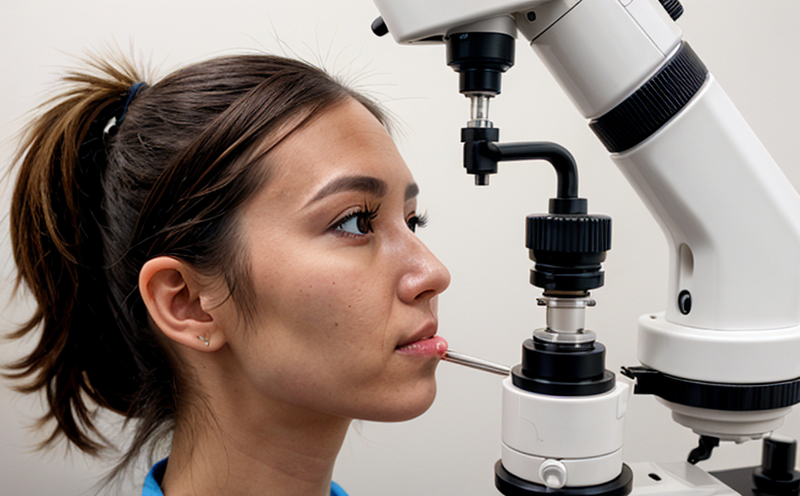ISO 15004-5 Ophthalmic Equipment Environmental Testing
The ISO 15004 series of standards provides comprehensive guidance on environmental testing for medical devices, with a specific focus on ophthalmic equipment. The fifth part, ISO 15004-5, addresses the environmental conditions that must be considered during the design and development stages to ensure the safety and efficacy of these devices under real-world use.
The standard covers various aspects such as temperature, humidity, altitude, and other environmental stressors. Compliance with this standard ensures that the ophthalmic equipment performs consistently across different climates and conditions, thereby enhancing patient safety and satisfaction. This testing is crucial for medical device manufacturers to meet regulatory requirements set forth by global bodies like the FDA (U.S.), MHRA (UK), and notified bodies.
Our laboratory adheres strictly to ISO 15004-5 standards when performing environmental tests on ophthalmic devices. We use state-of-the-art facilities equipped with climate chambers, altitude simulators, and other specialized equipment necessary for accurate testing. Our team of experts ensures that all tests are conducted meticulously, ensuring compliance with international standards.
The process involves careful preparation of the specimens to be tested, including sterilization procedures where applicable. After setup, we subject the devices to controlled environmental conditions designed to replicate real-world scenarios they might encounter during use. Data collection is continuous and comprehensive throughout each test cycle, providing detailed insights into how well the device withstands these conditions.
Upon completion of testing, our laboratory provides thorough reports detailing all findings. These documents serve as crucial evidence for manufacturers seeking regulatory approval or those looking to improve their products based on actual performance data. Our commitment to accuracy and reliability guarantees that every report aligns perfectly with both client expectations and industry benchmarks.
By adhering strictly to ISO 15004-5 standards, we ensure our clients receive high-quality testing results which are essential for successful product launches in various markets worldwide. This approach not only helps companies comply with regulatory requirements but also enhances brand reputation by demonstrating a strong commitment to quality and safety.
Our experienced staff stays updated on the latest developments within this field, ensuring that our services remain relevant and effective even as standards evolve over time. With years of experience in conducting ISO 15004-5 tests, we pride ourselves on delivering reliable results that meet or exceed expectations.
In summary, ISO 15004-5 testing plays an indispensable role in ensuring the safety and effectiveness of ophthalmic devices used by millions globally. By partnering with us for this critical service, your organization can benefit from our expertise while adhering to stringent international standards.
Industry Applications
The application of ISO 15004-5 environmental testing is widespread across the medical device industry. It applies particularly to ophthalmic devices such as contact lenses, intraocular lenses (IOLs), corneal implants, and various diagnostic tools used in eye care.
For contact lens manufacturers, understanding how their products behave under different climatic conditions is vital for ensuring comfort and safety when worn by users. Similarly, IOL suppliers must ensure that their devices maintain integrity during transportation or storage in diverse environments before implantation into patients' eyes.
Diagnostics equipment like corneal topography systems need to be robust enough to function correctly regardless of ambient conditions encountered during transport or usage. This testing helps manufacturers optimize product design, improve manufacturing processes, and ultimately enhance patient outcomes.
The results from these tests contribute significantly towards achieving regulatory compliance, which is essential for market entry in numerous countries around the world. Moreover, successful passage through rigorous environmental assessments can bolster a company's reputation among healthcare professionals and consumers alike.
Environmental and Sustainability Contributions
The pursuit of environmental sustainability within the medical device industry extends beyond mere compliance with regulations; it encompasses proactive efforts aimed at minimizing ecological impact throughout product lifecycle stages. By conducting thorough environmental testing according to ISO standards like 15004-5, manufacturers play a key role in advancing sustainable practices.
One significant area where this contributes is through enhanced durability and longevity of products. Devices that perform reliably under various environmental stresses require fewer replacements or disposals, thereby reducing waste generation. Additionally, improved design based on robust testing can lead to reduced resource consumption during manufacturing processes.
Another positive outcome of adhering to these standards lies in fostering innovation within the industry. Manufacturers who invest heavily in research and development aimed at meeting stringent environmental requirements often discover new materials or technologies that have broader applications beyond just compliance. These advancements contribute positively towards overall ecological health by promoting resource efficiency.
From an ethical standpoint, embracing sustainable practices not only benefits the environment but also enhances public trust in medical device manufacturers. Consumers increasingly value brands committed to responsible environmental stewardship, making it a strategic advantage for companies operating in today’s competitive market landscape.
Use Cases and Application Examples
The application of ISO 15004-5 testing extends across numerous scenarios relevant to ophthalmic device manufacturing. One common use case involves ensuring that contact lenses retain their shape and optical properties even after exposure to high humidity levels, which could occur during tropical climates.
For intraocular lenses (IOLs), testing focuses on durability under extreme temperature variations—such as those found in desert regions or cold polar areas. This ensures consistent performance post-surgical implantation regardless of geographical location.
Corneal topography systems undergo extensive environmental stress tests to confirm their accuracy remains unaffected by changes in atmospheric pressure during transport or extended storage periods.
Manufacturers also use these tests to identify potential weaknesses early on in the development process, allowing for corrective measures before large-scale production begins. Early detection of issues through rigorous testing helps reduce costly recalls and improves overall product quality.
In summary, ISO 15004-5 environmental testing serves multiple critical purposes within ophthalmic device manufacturing, from enhancing reliability under diverse conditions to driving innovation towards more sustainable practices.





